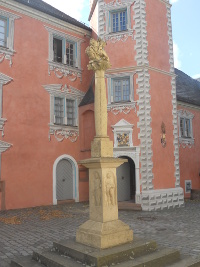
Multidimensional Perceptibility of Cultural Heritage (MUSIEKE)
Development of an Interdisciplinary Methodology to Optimize Measuring, Seeing and Understanding of Cultural Change in Real and Virtual Spaces
Which interdisciplinary point of view on cultural heritage is relevant for the future? Which approaches can be developed for the long-term sustainable protection of cultural heritage objects? How do processes of decision-making and awareness relate to new and changing perceptions brought in by scientific, economic, and social stakeholders? These are the main questions tackled in the research project MUSIEKE.
 The project aims at analysing interrelations between perceptions and experiences of cultural heritage: (1) in museum environments, (2) in urban spaces and their spatio-temporal entanglements with the surrounding (cultural) landscape, and (3) in virtual spaces. This comprises possibilities and limits of screening, viewing, projecting, and experiencing cultural heritage. At the same time, the process of historical-archaeological research will be documented. Here, the following steps and their interlock will be analysed: assessment, measuring, vision, perception, and understanding. The basis of this work is the acquisition and processing of physical evidence into 3-D models, which requires their storage in interoperable file formats as well as enabling their access from the internet. Various fields in applied research and humanities rely on this technical process of preparing data and rendering it accessible. In turn, applied and basic research on the analysis of measured and evaluated data provide a deeper understanding of contexts, interpretations, meanings, and conflicts connected to the identification, analysis, processing, and uses of cultural heritage. The Jupiter Column (“Iupittergigantensäule”) in Ladenburg will be used to test the interdisciplinary practices of making the various dimensions of cultural heritage perceptible. The Jupiter Column is an exemplary object representative of the rich cultural heritage of Ladenburg, a town with an impressive Roman history. Built roughly in 200 A.D. and destroyed shortly thereafter, it was only discovered in the 1970s, buried in a well. Lessons learnt from this case study will be gathered in a joint research concept. The overall aim is to develop a transferable methodology for interdisciplinary research on cultural heritage and its sustainable protection.
The project aims at analysing interrelations between perceptions and experiences of cultural heritage: (1) in museum environments, (2) in urban spaces and their spatio-temporal entanglements with the surrounding (cultural) landscape, and (3) in virtual spaces. This comprises possibilities and limits of screening, viewing, projecting, and experiencing cultural heritage. At the same time, the process of historical-archaeological research will be documented. Here, the following steps and their interlock will be analysed: assessment, measuring, vision, perception, and understanding. The basis of this work is the acquisition and processing of physical evidence into 3-D models, which requires their storage in interoperable file formats as well as enabling their access from the internet. Various fields in applied research and humanities rely on this technical process of preparing data and rendering it accessible. In turn, applied and basic research on the analysis of measured and evaluated data provide a deeper understanding of contexts, interpretations, meanings, and conflicts connected to the identification, analysis, processing, and uses of cultural heritage. The Jupiter Column (“Iupittergigantensäule”) in Ladenburg will be used to test the interdisciplinary practices of making the various dimensions of cultural heritage perceptible. The Jupiter Column is an exemplary object representative of the rich cultural heritage of Ladenburg, a town with an impressive Roman history. Built roughly in 200 A.D. and destroyed shortly thereafter, it was only discovered in the 1970s, buried in a well. Lessons learnt from this case study will be gathered in a joint research concept. The overall aim is to develop a transferable methodology for interdisciplinary research on cultural heritage and its sustainable protection.
ZAK | Center for Cultural and General Studies coordinates research activities conducted jointly with KIT Institute of Photogrammetry and Remote Sensing (IPF) , Heidelberg Center for Cultural Heritage (HCCH), Institute of Geography/ Research Group GIScience, Heidelberg University and the Forensic Computational Geometry Laboratory (FCGL), Heidelberg University.
Duration: Jan 2015-December 2015
Photo „Jupiter Column“: (c) Lobdengaumuseum Ladenburgh
